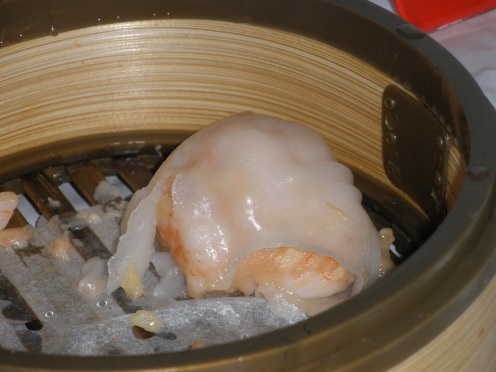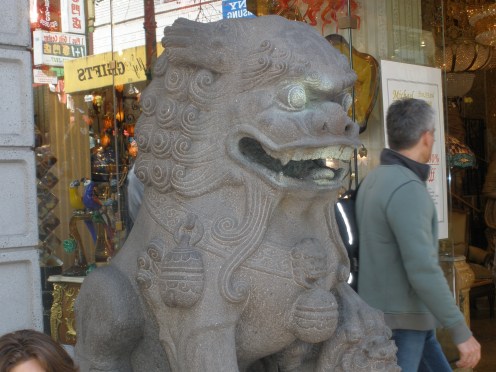Just a Tourist
I’ve been to Chinatown several times before, but for some reason every time I revisit a place in the city with my Eating San Francisco(ESF) class, I feel that I regress to a time when I was a child.

That’s me in the green sweater. Thanks to this picture taken by our professor, David Silver, it’s not easy to miss the fact that I was quite excited to be exploring San Francisco‘s Chinatown. But honestly, I believe I would be hard-pressed to find another student in my class who wasn’t enthusiastic about going to a class, which involves touring a place such as Chinatown and then eating Dim sum for lunch. I can’t say that I’ve ever had a class where this is possible, and perhaps this is the root of the joy that I experience when going on these fieldtrips.
However, after our fieldtrips to North Beach, the Mission, and the Castro, I’ve learned that the exhilaration that I feel is much more than this. Every other time that I’ve come to Chinatown, I’ve walked around, checked out some shops, and then left, much like any tourist might do. But this time in Chinatown, like my other fieldtrips, I came with a different frame of mind. I came to see more than your typical tourist might see on a given visit. My little silver digital camera may have looked fairly generic when compared to the passing tourist‘s cameras, but as opposed to relying on it for all my memories and taking numerous pictures every few steps like I see many tourists do, I used my camera as a tool to help remind me of the bigger picture, which can always be found in my mind.
As we walked on the sidewalks, further into the heart of Chinatown a few of my classmates and I noted that we didn’t feel like we were in San Francisco anymore. We had entered a world that somehow resembled a city in China.


A description of Chinatown in the travel section at Sfgate explains that it is divided into two Chinatowns: “One belongs to the locals, the other charms the tourists. They overlap and dance with each other, drawing more visitors annually than the Golden Gate Bridge.”
I find this description interesting. It makes me look at the term “tourism” in a different light. I’m sure, in this description, “locals” represent the Chinese people who live in Chinatown, and that “tourists” refer to all the people who come to visit, but who do not reside within the district. But, what about the Chinese people who visit Chinatown versus non-Chinese tourists? It seems that Chinese tourists might be able to fit in better with the local community of Chinatown than tourists who are not Chinese. I wonder if a Chinese person from Hong Kong would feel as much like a tourist as someone like me- a Caucasian young man from Idaho? In one respect, we could both be considered equal tourists in that we haven’t been to Chinatown in San Francisco. In another regard, however, the fact that Chinatown is full of Chinese cuisine, Chinese commodities, Chinese culture, and tons of people speaking Chinese, somebody such as myself would feel much further from home than a “tourist” visiting from a city in China such as Hong Kong. It appears that “tourism” is more complex than I once thought. Nevertheless, at the time I was walking up and down the sidewalks of Chinatown, tourism was the last thing on my mind. I was trying to immerse myself with everything that was going on around me. I wanted to get a glimpse of the life that was taking place behind the ubiquitous veil of tourism.


They are everywhere. People just living their lives. Tourism might be an industry that many of these Chinese Americans work in to make money, but beyond the tourism that we are often blinded by, these people are living normal lives.
When our class ate Dim sum at a place in Chinatown called New Asia, I felt particularly absorbed in the culture that surrounded us. There were literally hundreds of people having lunch around us, while a flurry of servers rolled their Dim sum carts to each table, hoping to make a sale. I never intended to eat beef stomach or chicken feet, but the occasion just seemed too interesting not to taste them.


I cannot say that I would try them again, but I definitely have a better appreciation for the recipes that were brought here by the Chinese people.

The dumpling that you see above was the last of several in this basket. They were my favorite. I ate them to fast, and mistakenly, without giving any thought about what they actually are. Thanks to the Asia Times online,” in an article by Chawadee Nualkhair called “The mysterious art of dumping cuisine,” I now know that delicacies such as dumplings, as well as noodles, were not possible until around the 3rd century BCE, when the grindstone arrived by way of the Silk Road. At this point the Chinese were then able to grind wheat into flour, add water, and essentially form dough. Unlike the westerners, however, who were known to bake and fry the dough, the Chinese stayed true to their cooking methods of boiling and steaming. This resulted, as Nualkhair points out, in the creation of “noodles, pancakes, steamed breads, and yes, dumplings, all called “ping” by the Chinese.”
This was my third time in Chinatown, yet I feel that there is still so much that I could learn about the people who live here, as well as the culture that they are a part of. It would be nice to feel less like the tourist that I know I am now, and more like a tourist from Hong Kong.


You went and sat on that hill in the Mission again, didn’t you Joel?? Not but really, this is great; insightful, well-written, informative, etc, etc, etc. You’ve outdone yourself, sir. But I wouldn’t worry about looking like a mega-tourist, you can’t help but feel that way when you’re with the paparazzi team that is ESF.